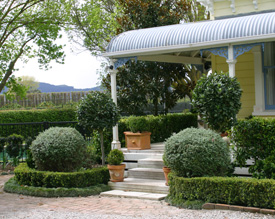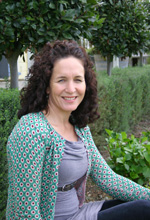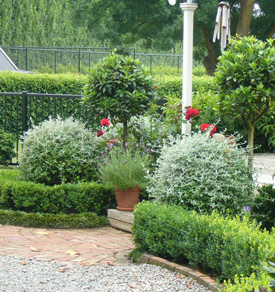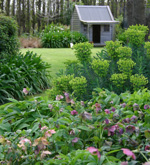Shades of green
Sue Linn meets a Gisborne gardener with a passion for foliage and form.
In Bron and Sandy Kemp’s garden there is always something in bloom. But more often than not, when Bron chooses plants for her garden, flowers are the last thing on her mind. Her colour palette is restricted to shades of green. For this budding garden designer, it’s all about shape.
She’s clear about her style, “Loads of green with pops of colour.” Bron’s pops of colour change with the seasons. When I visited in early September a graceful old flowering crab apple took centre-stage, its soft lime and pink tones complemented by lime Euphorbia, pink Bergenia, a stunning native kakabeak laden with bloom and broad expanses of Helleborus (winter rose). Moving into summer, the colour scheme heats up with red roses and mass plantings of blue flag irises. Later on, masses of white hydrangeas will steal the scene.
Bron’s love of shape and structure is evident both in her choice of strongly architectural plants and in the substantial framework of immaculately trimmed hedges and ball shaped shrubs, which provide year-round character.
Thankful that her orchardist husband is handy with the hedge trimmers, Bron gets to play with her planting schemes while Sandy keeps the hedges, topiary and lawns looking shipshape. “It’s amazing how a freshly mown lawn can make a garden look so much better, whatever state the rest of it is in,” she muses.
To screen the pool fence and separate the garden from their orchard, Bron and Sandy chose a hedge of glossy green Portugese laurel (Prunus lusitanica), and they’re still pleased they did. “It’s been an amazing hedge”, says Bron. “Visitors often ask me what it is. We planted little one year old plants from the nursery and they grew together in just three years”. The hedge is now six years old and kept at a height that Sandy can trim without standing on a ladder. “I love it in spring when it’s covered in bright green new growth” says Bron. Although, she points out they do have the odd problem with thrips in dry summer weather. The prunus hedges are trimmed around Christmas time and sprayed when necessary to control thrips.
Other favourites for trimming are English box, NZ Corokoias, and Australian Westringas. For silver accents Bron loves her Tuecrium fruticans balls but finds they grows so fast she needs to replace them every few years, despite frequent trimming. In an example of her knack with foliage combos, a cluster of clipped Pittosporum 'Stephens Island' contrasts beautifully with the large shiny leaves of Griselina lucida, which thrives in the frost-free location.
It’s been ten years since Bron gave up full time nursing to start a family. Around the same time she and Sandy found their dream property, an old villa surrounded by a kiwifruit and citrus orchard on the Gisborne plains. There wasn’t much of a garden when they arrived, except for some lovely mature trees. “They make it look as if the garden has been here forever.”
“I never had a plan,” says Bron, “I just started planting and worked around what was here.” Over the years, she has learned what works by trial and error. “I’m always moving things and I’ve made heaps of mistakes.” But from the outset Bron has enjoyed the support of some very accomplished gardeners. “Gardening is in my blood,” she confesses. “Nan and Mum were both very keen gardeners. My mother in law is also a very talented gardener.” While crediting her mentors for much of her knowledge, Bron has discovered her own distinct style. “Mum always told me to plant in odd numbers, threes and fives. I still do that, but most of the time I plant in much bigger numbers. I never buy one of anything, except maybe trees.”
As her garden grows, so does Bron’s plant knowledge, and her passion for garden design. She now finds herself embarking on a new career, designing gardens for others.
In contrast to her nursing years, Bron is thriving on the opportunity to indulge her creativity. Her garden is a place for her to experiment with new planting ideas and show ideas to clients. “One of the things I find most rewarding is coming up with a planting combo that works”.
But most of all it’s a garden designed for family life. The children make full use of the luxurious space that comes with country living, including a vegetable garden where they can see how healthy food grows. In summer, a grapevine-clad gazebo is a favourite spot for barbecues and picnics. The old concrete well next to it has been converted into a fire pit, ideal for extended summer evenings in the garden.
Bron and Sandy Kemp’s garden was one of a selection of Gisborne’s most beautiful gardens open to visitors during the 2011 Gisborne Garden and Arts Festival. This successful event will be repeated with more gardens in November 2013.
Q & A
What is it about gardening that you find most rewarding?
“Getting a plant combo that works! Visitors, friends and family loving my garden, and now working for myself doing something I love.”
What would you consider to be the biggest challenge in the garden?
Clay soil!
What is your biggest gardening disaster?
“Planting gardenias and lavenders two or three times before figuring out that they don’t like my soil.”
Who are the gardeners that inspire you?
“Peter Fudge and Paul Bangay, two Australian garden designers.”
What are some of your favourite plants?
“Rengarenga lilies (Arthropodium) are great for mass planting in dry shade. Buxus because it is tough and great for shaping. I’m mad on euphorbias. They’re fantastic fillers and I love their lime green flowers, great with purple hellebores. I adore hellebores for their colours and foliage, also hydrangeas for their leaf colour and shape, and awesome flowers.”
3-Nov-2012

English box, dwarf mondo grass, silver Teucrium ruticans, dark green bay trees and a fragrant hedge of port wine magnolia make a welcoming entranceway

Bron sits in front of an olive green Westringia hedge with dark green standard bay trees

Lime-green euphorbias and hellebores fill a shady space under a large golden ash tree near the childrens' playhouse

In summer, red roses add a bright punch of colour by the front entry step

